Knowing how to stop shoes from squeaking is an invaluable life skill. If you’ve ever proudly worn new shoes, only to have them squeak as you walk, you’ll know how annoying this can be.
In this article, I suggest my top 10 DIY hacks to stop a squeaky shoe. Some are only suitable for specific problems, so it’s worth figuring out why you have squeaky shoes in the first place.
Why Do My Shoes Squeak?
Squeaky shoes happen for different reasons depending on the style, age, floor type, and level of damage. The most common reasons for shoes squeaking are rubber soles, new leather insoles, and water damage. Doing a quick diagnostic of your shoes will help you decide which solution is best.
Here’s a brief rundown of the main reasons shoes squeak.
New Shoes
Leather shoes usually squeak when they’re new because of the insoles rubbing against the shoe’s inside. It’s caused by friction between the leather surfaces, as most have smooth leather interiors. Shoe squeaking typically occurs around the toe joints in this case.
Trapped Air and Moisture
Similarly to the above problem, air and moisture trapped under a loose insole can squeak when you step. The noise is the air being ejected from a small pocket, which is only made worse by moisture. It usually happens with removable insoles around the arch area.
Rubber Soles
Rubber shoe soles squeak on linoleum, tiles, and rubberized flooring because both surfaces are smooth. Again, it’s caused by friction between your shoe and the surface, which is particularly evident as you lift your foot up.
Wear and Tear
Unfortunately, old shoes can squeak too. It’s usually caused by parts rubbing against each other or by components coming loose. Squeaking can occur as soles come loose or as leather parts rub together inside.
Older shoes contain something called a metal shank, a piece of metal embedded in the sole that supports the arch. It’s less common in modern shoes, but can be a major source of squeaking as it rubs against the rubber or leather sole unit.
Water Damage
Finally, we have the problem of water damage. Almost all components in a shoe can absorb water to some degree. Water will make soles squeak more on hard floors and can make the problem of parts rubbing together more obvious.
But, it’s also one of the easiest issues to fix. Water can cause permanent damage to leather, although it’s often just some light staining.
10 Solutions for How to Stop Shoes From Squeaking
Before you move on to how to fix squeaky shoes, think about why your shoes squeak. Things like water damage are obvious, but interior squeaks less so. Listen to where you think the noise is coming from and narrow it down using the suggestions above.
Of course, if you can’t find an obvious reason for why your shoes squeak, it’ll be worth speaking to a professional. A cobbler (if they still exist in your neighborhood) could have answers, or it might be worth getting a replacement pair if these solutions don’t work.
On that note, here are my top suggestions for how to stop shoes from squeaking.
1. Dry them out
Let’s start with the obvious: solving water damage. It’s the easiest to diagnose (as you’ll know when your shoes are wet) and also the easiest to solve.
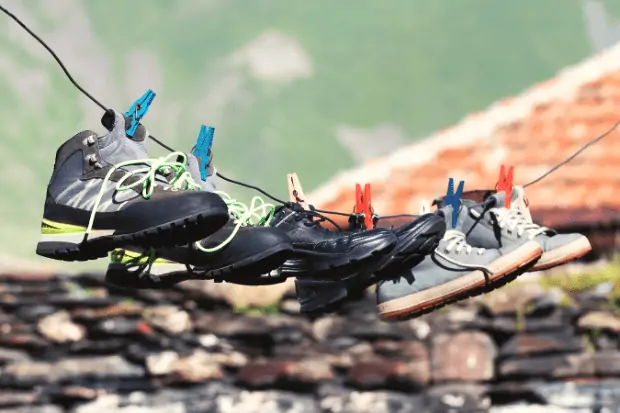
I’m not talking about slightly sweaty shoes here but rather shoes you wore in the rain. I suggest ways to fix sweaty shoes below, so scroll down to find those.
The method for drying out shoes depends on what they’re made from. Canvas or fabric shoes can be thrown in the dryer, as they’re not much different from clothes. Put each shoe in a pillowcase to stop them from damaging your dryer.
Leather shoes, however, need more careful treatment. They need less intense heat otherwise they’ll shrink and crack.
The easiest way to dry them out is to stuff them with newspaper and leave them somewhere warm but not on direct heat. For example, a boiler cupboard is ideal.
If they take longer than a day, replace the newspaper every 24 hours. Be sure to use a leather conditioner to restore moisture to them, and clean off any stains with saddle soap before you dry them.

2. Rough up the soles
Almost all shoes have some kind of rubber soles. For smart and dress shoes, it’s often EVA foam, whereas sneakers use plain rubber. New rubber soles are a major cause of squeaky shoes, particularly on hard floors.

While you could wait for them to wear down themselves, it’s easy to speed up the process. Simply rub the soles with sandpaper to rough them up slightly. I recommend using fine sandpaper (such as 120 grit or higher) so you don’t cause too much damage.

Leather soles and other hard materials shouldn’t squeak on hard floors. If they do, use the finest sandpaper possible.
Start off with a small amount of sanding and try them out if possible. Try not to overdo it, as the more sole you sand off, the less time your shoes will last.
Alternatively, if you don’t want to use fine grit sandpaper, try rubber sole spray. Rubber sole spray is a product used to give your shoes more grip. It’s more expensive than sandpaper but means you don’t have to cause unnecessary damage.

3. Moisturize the insides
As mentioned above, shoes with leather insides can squeak as the parts rub together. It’s more common with new shoes, although worn insoles can squeak too. However, that needs a different solution, which you’ll find below.
To solve new squeaky shoes, moisturize the insides. You can use leather conditioner for this, as it’ll last for quite a while. Alternatively, petroleum jelly (such as Vaseline) works wonders.
If you’re using petroleum jelly, apply a tiny amount to the spot you think is squeaking using a cotton ball. It’ll usually be around the toe joints if this is the problem, so rub a bit in there. I recommend removing the insoles first if you can.
But, bear in mind that petroleum jelly won’t soak into the leather as a leather conditioner will. You might end up with greasy socks and feet, which is why I recommend using it sparingly. Coconut oil could do the job, too, but has the same drawbacks.
You’ll find this is more of a problem with dress shoes, particularly those with removable insoles. Sneakers shouldn’t have much inside that’ll squeak. But, if they do, it’s probably not something you could solve anyway as you can remove components in the same way.
4. Fix broken bits
Stopping old shoes from squeaking is pretty easy. Usually, it’ll be loose sole units that squeak, often as air escapes through small holes. To solve this, we can rely on our trusty friend super glue.
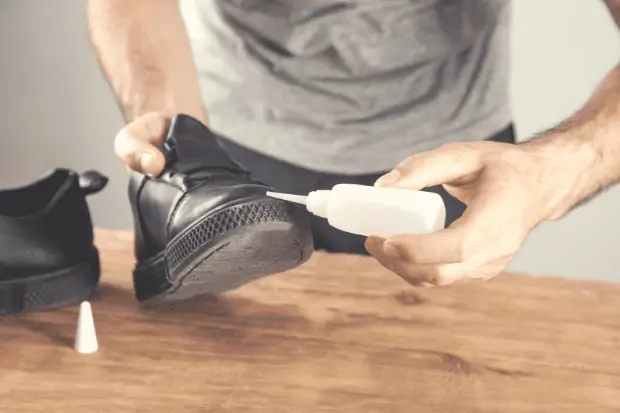
Spot small amounts of super glue into the hole and apply pressure as it dries. The glue hardens in less than 60 seconds, but will cure and have the best mechanical adherence 24 hours after application. It might be worth getting some woodworking clamps for this, so you don’t have to stand for hours holding your shoe together.
I recommend this method more for sneakers and casual shoes than formal shoes, although it’s possible to do it on foam- and rubber-soled shoes. If you have leather soles that are squeaking due to damage, your best option would be to visit shoe repair shops, which can completely resole them.
Almost all shoes with composite sole units (foam, rubber, etc.) can’t be resoled because of how they’re made. By all means, see if a cobbler could repair them, but they might not do much more than glue them back together.
5. Use baby powder
Baby powder (or talcum powder) is a classic fix-all moisture absorber. As such, it’s a good solution for cutting down on moisture in your shoes. It’s also great for reducing friction between interior components, another reason your shoes squeak.

For instance, talcum powder is often applied to prevent floorboards from squeaking.
If you can, remove the insoles and sprinkle them with baby powder. Do the same inside the shoes and move them around so it distributes evenly. You can still sprinkle baby powder in your shoes if you can’t take the insole out, but it might not solve the problem.
Be smart about when you apply baby powder to your squeaky shoes, though. Leave them a few hours after you take them off. While it’s great at absorbing moisture, particularly sweaty shoes will just create a pasty mess, which is less than ideal next time you wear them.
You’ll need to reapply baby powder every few wears, so it’s not a great long-term solution. It’ll work well in a pinch though, providing you have some on hand.
6. Keep the leather moisturized
It’s worth stressing this point again because it makes a massive difference. Regularly apply leather conditioner to your shoes, particularly around the toe joint and lace areas.
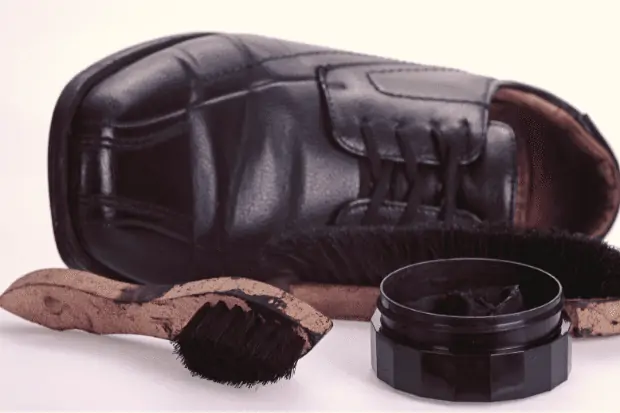
Leather is animal skin, and much like your skin, it needs moisturizing. Doing so will not only make your shoes last longer, it’ll also stop them from squeaking.
Most leather conditioners are meant for the outside of shoes, but nothing is stopping you from using them inside the shoes, too. Apply it roughly once a month, or more if you wear them every day.
7. Try dryer sheets
Dryer sheets can solve 2 problems: squeaky soles and squeaky insides. Rubbing a dryer sheet on the bottom of your shoes coats them with a thin layer of fabric softener. It can stop shoes from squeaking because it’s essentially like adding a layer of moisturizer.

Also, try adding a dryer sheet inside the shoe, ideally under the insole if you can remove it. The dryer sheet acts as a barrier between leather surfaces, so should stop them from rubbing together and squeaking.
Plus, as an added bonus, it’ll stop your shoes from smelling!
Much like baby powder, dryer sheets aren’t a long-term solution. You’ll need to rub the soles every few wears and replace the ones inside your shoes every few weeks.
8. Use a water protection spray
A shoe protector spray is a must-have for anyone wanting to preserve their shoes. The spray is hydrophobic, meaning water runs off the shoes rather than soaking into the material.
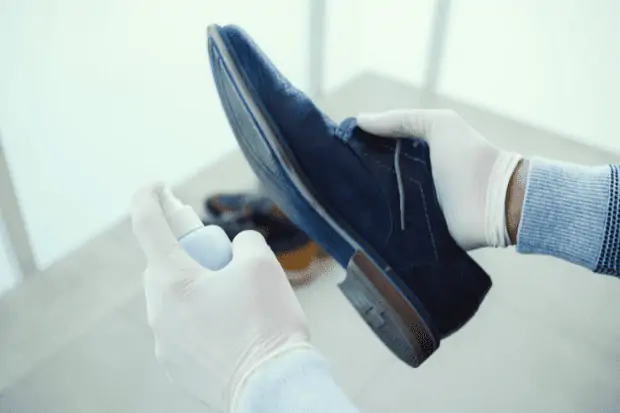

You can use it on all shoe materials, but it’s particularly useful on suede, canvas and fabric.
It stops your shoes from getting wet, meaning you can avoid the worst of squeaky shoes caused by water damage. But, it’s only really suitable for light rain or similar. Don’t expect to have dry feet if you plan on jumping in puddles!

9. Replace laces
Laces can make shoes squeak by creating friction around the eyelets. It’s a common problem in new shoes but can also happen in older suede shoes. The friction essentially turns the suede to leather, giving the laces a squeakier surface to rub against.
Simply swap laces out for new ones (thinner is better). Also, avoid leather or waxes laces, as these’ll make the problem worse.
The best option is polyester laces, regardless of whether they’re for casual or dress shoes. They’ll create the least friction compared to other kinds.

You could also try rubbing the lace and tongue area with saddle soap to reduce friction (only on leather).
10. Use silica gel
Silica gel is a great product for absorbing moisture and is ideal for use on sweaty shoes. I recommend finding a reusable silica gel, such as the kind used for drying flowers. It’ll mean less waste and that you always have the product on hand.
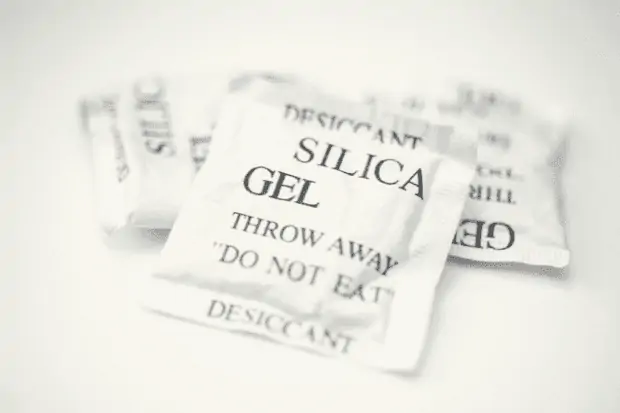
Sprinkle some inside your shoes or wrap in tissue paper or some other porous material. Silica gel will help absorb excess moisture, which could make squeaky shoes worse.
You could use it to dry out water damage, but it might take a long time. For overly wet shoes, newspaper is usually the easiest product.

Final Thoughts on Squeaky Shoes
I hope the suggestions above will help you stop your shoes from squeaking. It’s an annoying problem that I imagine most of us have faced at some point. Luckily, as you can see, there are numerous ways to solve it.
Make sure you try to work out why your shoes are making a squeaky noise, as it’ll impact what solution you use and where you apply it.
Do you have any other recommendations for how to stop shoes from squeaking? I’d love to hear from you below, the more creative, the better!

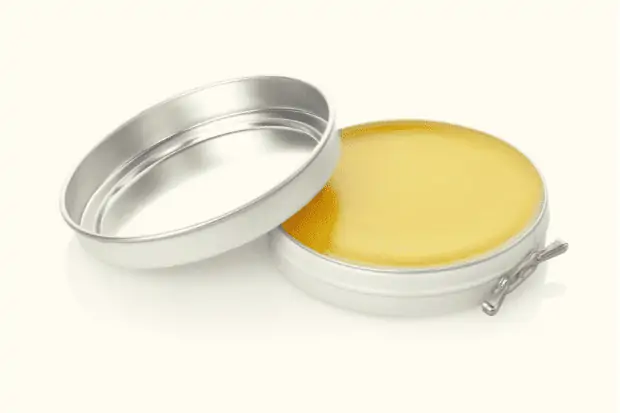



2 thoughts on “10 Tips: How to Stop Shoes from Squeaking on any Floor type”
I think it is the floor cleaner rather than my shoes, as ALL my shoes are squeaking just on the hardwood. Any recommendations for squeak-proof floor cleaner?
Hi Joanne – I have the same problem. We have Karndean floor and it was fine until I used their floor cleaner and now all the hard surfaces in the house squeak. It driving me mad and I’ve tried everything. I’m guessing I’ll have to wait for the floor cleaner to finally disperse but this has been going on now since January. Did you find a solution? My name is also Joanne! .